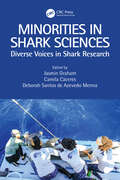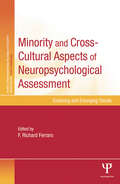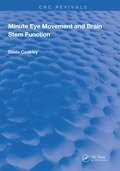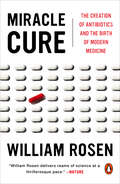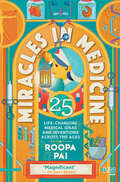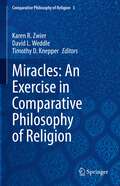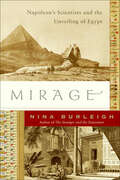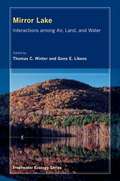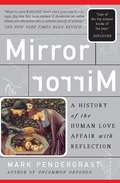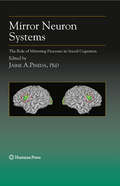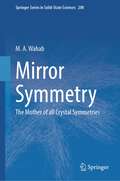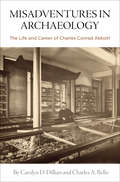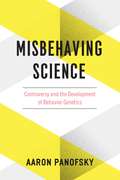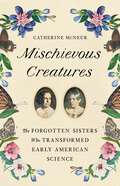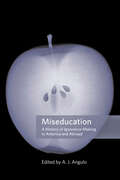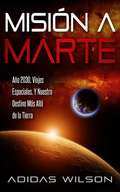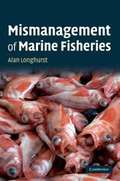- Table View
- List View
Minorities in Shark Sciences: Diverse Voices in Shark Research
by Jasmin Graham Camila Cáceres Deborah Santos de Azevedo MennaMinorities in Shark Sciences showcases the work done by Black, Indigenous and People of Color around the world in the fields of shark science and conservation. Edited by three minority researchers, it provides positive role models for the next generation. Highlighting new and important research done in the fields of biology, ecology, and evolution, the book places emphasis on scientists with diverse backgrounds and expertise from around the world. The heart of this book is that community and minority voices are important (and have always been) to science regardless of diplomas/universities/accolades/western standards of academia. Despite the use of the term ‘Minorities’, most of the world’s population do not identify as white nor male, and in fact all "minorities" together comprise the global majority of humans. For those in these historically underserved and underrepresented demographics, it is meaningful to be highlighted and be given credit for their contributions. This book showcases to the world the many Black, Indigenous, People of Color, and LGTBQ+ scientists leading marine conservation, both in terms of scientific research and science communication. It has been shown in the literature that diversity in scientists creates diversity in thought, which leads to innovation. Strong minority voices are exactly what is needed to bring greater attention to the conservation of sharks, and this book illustrates innovative science by people who were historically excluded from STEM. It highlights the unique perspectives these scientists bring to their field that allow them to interact with stakeholders, particularly in the areas of conservation and outreach. As we continue to amplify these often-forgotten voices through research, outreach and engagement, we hope to stimulate innovation and transformative change in the field of shark conservation and marine science.
Minority Perspectives (Routledge Revivals)
by Dale Rogers Marshall Bernard Frieden Daniel Wm. FesslerOriginally published in 1972, Minority Perspectives is the second in a series exploring metropolitan problems within the government structure. The 1960’s were a period of civils rights movements as well as poverty in the United States and in the 70’s, it became clear that poverty was closely linked to race. This report sets out to explore issues contributing to the metropolitan-minority poverty problem such as racial exclusion and public policy. The papers included in this report discuss issues such as political power in metropolitan areas, the impact an address can have on economic opportunity for minority groups and the effects that laws and litigation can have on poverty. This title will be of interest to students of environmental and urban studies.
Minority and Cross-Cultural Aspects of Neuropsychological Assessment: Enduring and Emerging Trends (Studies on Neuropsychology, Neurology and Cognition)
by F. Richard FerraroMinority and cross-cultural psychology is more relevant now than ever in our diverse world. Given the dramatic local and global changes occurring daily with regard to demographics, population changes, and immigration issues, minority and cross-cultural psychology is fast becoming a respected and critical area of scientific study. Pair that with the fact that people of all cultures and racial groups are living longer and experiencing age-related diseases and disorders, one can easily see the need for additional work on issues related to neuropsychological assessment. This new edition brings to the forefront recent developments by seasoned experts in the field. They offer up their newest projects in minority and cross-cultural aspects of neuropsychological assessment and are joined by new, up-and-coming professionals across a wide array of disciplines including psychology, medicine, and neuropsychology. Like the first edition, this updated collection sheds light on the ever-growing need for adequate neuropsychological assessment to a wider subset of individuals, crossing many cultural and minority barriers in the process. Continuously pushing the boundaries of neuropsychological assessment, this collection is essential reading for cognitive and clinical psychologists, and neuropsychologists, and a model text for advanced courses dealing with minority and cross-cultural issues.
Mint: The Genus Mentha (Medicinal and Aromatic Plants - Industrial Profiles)
by Brian M. LawrenceFor thousands of years mint has enjoyed an honored place in pharmacopoeias and kitchen cupboards in India, China, Europe, North America, and elsewhere. Today the amount of essential oils produced from the four major mint species (cornmint, peppermint, Native spearmint, and Scotch spearmint) exceeds 23,000 metric tonnes annually with a market value
Minute Eye Movement and Brain Stem Function (Routledge Revivals)
by Davis CoakleyFirst Published in 1983: This book describes a technique developed over the last decade which uses minute eye movement as a monitor of brain stem function.
Miombo Woodlands in a Changing Environment: Securing the Resilience and Sustainability of People and Woodlands
by Yemi Katerere Natasha S. Ribeiro Paxie W. Chirwa Isla M. GrundyBased on work by the Miombo Network in southern Africa, this book helps decision-makers and general readers alike improve their understanding of the socio-ecology of the Miombo woodlands across southern Africa. It also highlights the importance of and the need for further research on the unique Miombo ecology and its link with economic development. One major challenge facing these woodlands is the influence that direct (both natural and anthropogenic) and indirect drivers of change, as well as interactions between these, have had over the centuries. As such the book explores the socio-economic and ecological interactions that occur in these woodlands and discusses the need for further research to provide a better understanding of these interactions.Drawing on data and information from numerous studies conducted in the last 20 years, the book presents a comparative analysis of policy changes and management experiences in the countries concerned. It also addresses issues of global climate change, since they have an impact on Miombo ecosystem management and restoration, and provides future projections based on an assessment of how climate change has affected the Miombo woodlands in the past.
Miracle Cure: The Creation of Antibiotics and the Birth of Modern Medicine
by William RosenFor fans of Microbe Hunters: The epic history of how antibiotics were born, saving millions of lives and creating a vast new industry known as Big Pharma.As late as the 1930s, virtually no drug intended for sickness did any good; doctors could set bones, deliver babies, and offer palliative care. That all changed in less than a generation with the discovery and development of a new category of medicine known as antibiotics. By 1955, the age-old evolutionary relationship between humans and microbes had been transformed, trivializing once-deadly infections. William Rosen captures this revolution with all its false starts, lucky surprises, and eccentric characters. He explains why, given the complex nature of bacteria—and their ability to rapidly evolve into new forms—the only way to locate and test potential antibiotic strains is by large-scale, systematic, trial-and-error experimentation. Organizing that research needs large, well-funded organizations and businesses, and so our entire scientific-industrial complex, built around the pharmaceutical company, was born. Timely, engrossing, and eye-opening, Miracle Cure is a must-read science narrative—a drama of enormous range, combining science, technology, politics, and economics to illuminate the reasons behind one of the most dramatic changes in humanity’s relationship with nature since the invention of agriculture ten thousand years ago.
Miracles in Medicine: 25 Life-changing Medical Ideas and Inventions Across the Ages
by Roopa PaiCan you imagine a world where surgeries and amputations were conducted without anaesthesia?OUCH! Or one in which disease was believed to be caused by 'stinky air'?WEIRD!Or a world where treating madness involved drilling a hole through the skull to release the supposed 'demons' inside your head?SAY WHAAAAA...?!Guess what? That was our world, just about 250 years ago! All of this began to change in the eighteenth century with the coming of modern medicine. This brave new science, full of brilliant breakthroughs, was built on the hard work, dedication and persistence of thousands of curious minds across the ages, from Arabia to China and India to Europe. Packed with fascinating stories, insights and illustrations, this book is a celebration of 2,500 years of human endeavour and innovation in the medical sciences. Read it, and raise a rousing cheer to the amazing people who gave their all to unravel the secrets of the natural world and the human body, so that we could live longer, healthier and happier lives.
Miracles in Said Nursi and Thomas Aquinas: Non-Noninterventionist Approaches to Divine Action and the Sciences (Routledge Science and Religion Series)
by Edmund Michael LazzariIn order to preserve contemporary understandings of the sciences, many figures of the Divine Action Project (DAP) held that God could never violate or suspend a law of nature, causing the marginalization of miracles from scholarly theology–science dialogue. In the first substantive entry of interreligious dialogue on the topic, this book provides fresh, contemporary accounts of Said Nursi and Thomas Aquinas on miracles and science, challenges contemporary noninterventionist presuppositions, and explores rich, untapped avenues in the theology, metaphysics, and epistemology of miracles and laws of science. Through an exploration of Nursi’s Ash’arite, Quranic interpretation of the sciences, and St. Thomas’s neglected doctrine of obediential potency, this volume marshals powerful tools from the world’s two largest religions to elucidate the foundations of God’s interaction with creatures.As well as contributing to the contemporary debate, this volume provides Muslim and Christian readers alike substantive intellectual frameworks in which to think about the sciences from the heart of their own intellectual traditions, while at the same time giving them as alternatives to mainstream contemporary approaches for scientists and other readers engaged in theology–science dialogue.
Miracles: An Exercise in Comparative Philosophy of Religion (Comparative Philosophy of Religion #3)
by David L. Weddle Timothy D. Knepper Karen R. ZwierThis volume provides a comparative philosophical investigation into a particular concept from a variety of angles—in this case, the concept of “miracle.” The text covers deeply philosophical questions around the miracle, with a multiplicity of answers. Each chapter brings its own focus to this multifaceted effort. The volume rejects the primarily western focus that typically dominates philosophy of religion and is filled with particular examples of miracle narratives, community responses, and polemical scenarios across widely varying religious contexts and historical periods. Some of these examples defy religious categorization, and some papers challenge the applicability of the concept “miracle,” which is of western and monotheistic origin. By examining miracles thru a wide comparative context, this text presents a range of descriptive content and analysis, with attention to the audience, to the subjective experiences being communicated, and to the flavor of the narratives that come to surround miracles. This book appeals to students and researchers working in philosophy of religion and science, as well those in comparative religion. It represents, in written form, some of the perspectives and dialogue achieved in The Comparison Project’s 2017–2019 lecture series on miracles. The Comparison Project is an enterprise in comparing a variety of religious voices, allowing them to stand in dialogue.
Miraculous Medicines and the Chemistry of Drug Design (Global Science Education)
by Nathan KeighleyThe subject of chemistry is widely acknowledged as being conceptually challenging, and regarded with a perceived elitism. This book aims to address this dilemma by breaking down the fundamentals of organic chemistry and its importance in medicine, so that readers with any or no background education in chemistry can access the material and gain an appreciation and understanding for the subject. The text is written in a clear and concise manner, using appropriate figures, to explain how the medicine we are so familiar with is designed and produced. Undergraduate students, medical and nursing students, and general audiences will benefit from the accessible format and enjoyable read. Key Features: User-friendly text dealing with the chemical sciences for the non-scientist Public understanding of science at the interface of biology and chemistry is in high demand The book serves to introduce organic chemistry and its relevance to medicine Describes the foundational principles of chemistry without losing the systematic rigor of the subject
Mirage: Napoleon's Scientists and the Unveiling of Egypt
by Nina BurleighThe story of Napoleon’s invasion of the Nile Valley, the scholars and scientists who tagged along, and the birth of Egyptology: “A fascinating read.” —San Francisco ChronicleTwo hundred years ago, only the most reckless or eccentric Europeans had dared to traverse the unmapped territory of the modern-day Middle East. But in 1798, more than 150 French engineers, artists, doctors, and scientists—even a poet and a musicologist—traveled to the Nile Valley under the command of Napoleon Bonaparte and his invading army. Hazarding hunger, hardship, uncertainty, and disease, Napoleon’s “savants” risked their lives in pursuit of discovery. The first large-scale interaction between Europeans and Muslims in the modern era, the audacious expedition was both a triumph and a disaster, resulting in finds of immense historical and scientific importance (including the ruins of the colossal pyramids and the Rosetta Stone) and in countless tragic deaths through plague, privation, madness, or violence.In this account, journalist and New York Times–bestselling author Nina Burleigh brings readers back to the landmark adventure at the dawn of the modern era that ultimately revealed the deepest secrets of ancient Egypt to a curious continent.“An absorbing glimpse of Napoleon’s thwarted bid for a grand French empire and its intellectual fruits.” —Publishers Weekly“Pepper[ed] with multitudes of facts, digressions and anecdotes.” —The New York Times Book Review (Editor’s Choice) “Illuminates an unfamiliar moment in the history of science . . . Burleigh’s storytelling ability is mesmerizing.” —Library Journal
Mirror Image: The Clone Series (The Clone Series #1)
by Trish MoranThe first in Trish Moran's acclaimed young adult series exploring humanity, technology, and the problems of growing up in a dystopian future. Perfect for fans of The Giver and the Divergent trilogy.What happens when unscrupulous people take technology into their own hands?When fifteen-year-old Stella runs away from home she comes across a group of teenagers living in a hidden camp. They are the Labs- clones secretly made to replace the body parts of the rich and famous - who have escaped the sinister 'Centre' where they were created.The group blends into human culture with Stella's help. But the Centre is looking for them and there are still clones inside, facing certain death once they are no longer useful.Once the truth about the Centre's work is uncovered, the Labs hope they will finally have justice.Can Stella and her friends find a voice in their struggle for equality?
Mirror Image: The Clone Series (The\clone Ser. #1)
by Trish MoranThe first in Trish Moran's acclaimed young adult series exploring humanity, technology, and the problems of growing up in a dystopian future. Perfect for fans of The Giver and the Divergent trilogy.What happens when unscrupulous people take technology into their own hands?When fifteen-year-old Stella runs away from home she comes across a group of teenagers living in a hidden camp. They are the Labs- clones secretly made to replace the body parts of the rich and famous - who have escaped the sinister 'Centre' where they were created.The group blends into human culture with Stella's help. But the Centre is looking for them and there are still clones inside, facing certain death once they are no longer useful.Once the truth about the Centre's work is uncovered, the Labs hope they will finally have justice.Can Stella and her friends find a voice in their struggle for equality?
Mirror Lake: Interactions Among Air, Land, and Water
by Thomas C. Winter Gene E. LikensLakes change constantly in response to their surrounding landscape, and their airshed. Mirror Lake, located in the White Mountains of New Hampshire, has been carefully researched since the 1960s. This book, edited by Thomas C. Winter and Gene E. Likens, summarizes and interprets the extensive data collected on this lake and its watershed from 1981 to 2000, a period during which the lake was affected by a variety of climate conditions as well as significant human activity. The findings documented also identify the panoply of chemicals influenced by limnological processes and include percentages of inflow sources, percentages of water loss from seepage, surface outflow, and evaporation, and the effect of water flow on the lake nutrients.
Mirror Mirror: A History of the Human Love Affair with Reflection
by Mark PendergrastAs our first technology for contemplation of the self, the mirror is arguably as important an invention as the wheel and perhaps even more universal. Mirror Mirror is the fascinating story of the mirror's invention, refinement, and use in an astonishing range of human activities-from the bloodthirsty smoking gods of the Toltecs, to the fantastic mirrored rooms wealthy Romans created for their orgies, to the mirror's key role in the use and understanding of light. From Archimedes to Isaac Newton to Max Factor to David Hockney, this is the fascinating tale of one of the most remarkable inventions in human history and its effects on myth, religion, science, manners, and the arts.
Mirror Neuron Systems
by Jaime A. PinedaThe discovery of mirror neurons and of a mirror neuron system in the human brain raises the interesting possibility that "mirroring" may constitute novel instances of mental simulation. It also provides the basis for unique processes such as "mindreading", the ability to make inferences about the actions of others. That an elementary process in motor cognition may be foundational to mindreading goes a long way in providing a rational basis for the study of social cognition. Social cognition is a broad discipline that encompasses many issues not yet adequately addressed by neurobiologists. In Mirror Neuron Systems: The Role of Mirroring Processes in Social Cognition, leading thinkers in this nascent field craft chapters aimed at sparking a dialogue regarding the relevance of mirroring neural systems in cognition. Thought-provoking and cutting-edge, Mirror Neuron Systems: The Role of Mirroring Processes in Social Cognition provides the basis for extended discussion among interested readers and lays down the guidelines for future research in this fascinating and expanding field. It addresses issues common to different perspectives, raises contrary views, and creates the basis for an extended dialogue and discussion.
Mirror Symmetry: The Mother of all Crystal Symmetries (Springer Series in Solid-State Sciences #200)
by M. A. WahabThis graduate-level textbook deals with different aspects of plane mirrors and mirror-related symmetries. It provides us with some new ways of understanding symmetries in crystals and the mirror combination schemes. The inclusion of topics such as the Wigner–Seitz unit cell, reciprocal lattice, Brillouin zones, diffraction of crystals, etc., based on the mirror combination scheme, are extremely helpful in understanding many other concepts in crystallography. A mirror is the only fundamental symmetry in crystals, and all other permissible symmetries in crystalline solids can be derived from suitable combinations of mirrors, called derived symmetries. A rudimentary knowledge of symmetry in crystallography is essential to students, researchers, and professionals in many subjects in science and technology: physics, chemistry, mathematics, molecular biology, geology, metallurgy, and particularly materials science and mineralogy.
Misadventures in Archaeology: The Life and Career of Charles Conrad Abbott
by Carolyn D. Dillian Charles A. BelloA comprehensive portrait of the controversial self-taught archaeologist C. C. Abbott.In the late nineteenth century, Charles Conrad Abbott, a medical doctor and self-taught archaeologist, gained notoriety for his theories on early humans. He believed in an American Paleolithic, represented by an early Ice Age occupation of the New World that paralleled that of Europe, a popular scientific topic at the time. He attempted to prove that the Trenton gravels—glacial outwash deposits near the Delaware River—contained evidence of an early, primitive population that pre-dated Native Americans. His theories were ultimately overturned in acrimonious public debate with government scientists, most notably William Henry Holmes of the Smithsonian Institution. His experience—and the rise and fall of his scientific reputation—paralleled a major shift in the field toward an increasing professionalization of archaeology (and science as a whole).This is the first biography of Charles Conrad Abbott to address his archaeological research beyond the Paleolithic debate, including his early attempts at historical archaeology on Burlington Island in the Delaware River, and prehistoric Middle Woodland collections made throughout his lifetime at Three Beeches in New Jersey, now the Abbott Farm National Historic Landmark. It also delves into his modestly successful career as a nature writer. As an archaeologist, he held a position with the Peabody Museum at Harvard University and was the first curator of the American Section at the Penn Museum. He also attempted to create a museum of American archaeology at Princeton University. Through various sources including archival letters and diaries, this book provides the most complete picture of the quirky and curmudgeonly, C. C. Abbott.
Misbehaving Science: Controversy and the Development of Behavior Genetics
by Aaron PanofskyBehavior genetics has always been a breeding ground for controversies. From the "criminal chromosome” to the "gay gene,” claims about the influence of genes like these have led to often vitriolic national debates about race, class, and inequality. Many behavior geneticists have encountered accusations of racism and have had their scientific authority and credibility questioned, ruining reputations, and threatening their access to coveted resources. In Misbehaving Science, Aaron Panofsky traces the field of behavior genetics back to its origins in the 1950s, telling the story through close looks at five major controversies. In the process, Panofsky argues that persistent, ungovernable controversy in behavior genetics is due to the broken hierarchies within the field. All authority and scientific norms are questioned, while the absence of unanimously accepted methods and theories leaves a foundationless field, where disorder is ongoing. Critics charge behavior geneticists with political motivations; champions say they merely follow the data where they lead. But Panofsky shows how pragmatic coping with repeated controversies drives their scientific actions. Ironically, behavior geneticists’ struggles for scientific authority and efforts to deal with the threats to their legitimacy and autonomy have made controversy inevitable--and in some ways essential--to the study of behavior genetics.
Misbehaving Science: Controversy and the Development of Behavior Genetics
by Aaron PanofskyBehavior genetics has always been a breeding ground for controversies. From the “criminal chromosome” to the “gay gene,” claims about the influence of genes like these have led to often vitriolic national debates about race, class, and inequality. Many behavior geneticists have encountered accusations of racism and have had their scientific authority and credibility questioned, ruining reputations, and threatening their access to coveted resources. In Misbehaving Science, Aaron Panofsky traces the field of behavior genetics back to its origins in the 1950s, telling the story through close looks at five major controversies. In the process, Panofsky argues that persistent, ungovernable controversy in behavior genetics is due to the broken hierarchies within the field. All authority and scientific norms are questioned, while the absence of unanimously accepted methods and theories leaves a foundationless field, where disorder is ongoing. Critics charge behavior geneticists with political motivations; champions say they merely follow the data where they lead. But Panofsky shows how pragmatic coping with repeated controversies drives their scientific actions. Ironically, behavior geneticists’ struggles for scientific authority and efforts to deal with the threats to their legitimacy and autonomy have made controversy inevitable—and in some ways essential—to the study of behavior genetics.
Mischievous Creatures: The Forgotten Sisters Who Transformed Early American Science
by Catherine McNeurThe untold story of two sisters whose discoveries sped the growth of American science in the nineteenth century, combining "meticulous research and sensitive storytelling" (Janice P. Nimura, New York Times-bestselling author of The Doctors Blackwell) In Mischievous Creatures, historian Catherine McNeur uncovers the lives and work of Margaretta Hare Morris and Elizabeth Carrington Morris, sisters and scientists in early America. Margaretta, an entomologist, was famous among her peers and the public for her research on seventeen-year cicadas and other troublesome insects. Elizabeth, a botanist, was a prolific illustrator and a trusted supplier of specimens to the country&’s leading experts. Together, their discoveries helped fuel the growth and professionalization of science in antebellum America. But these very developments confined women in science to underpaid and underappreciated roles for generations to follow, erasing the Morris sisters&’ contributions along the way.Mischievous Creatures is an indelible portrait of two unsung pioneers, one that places women firmly at the center of the birth of American science.
Miseducation: A History of Ignorance-Making in America and Abroad
by A. J. AnguloA provocative collection that explores how intentional ignorance seeps into formal education.Honorable Mention for the PROSE Education Theory Award of the Association of American PublishersIgnorance, or the study of ignorance, is having a moment. Ignorance plays a powerful role in shaping public opinion, channeling our politics, and even directing scholarly research. The first collection of essays to grapple with the historical interplay between education and ignorance, Miseducation finds ignorance—and its social production through naïveté, passivity, and active agency—at the center of many pivotal historical developments. Ignorance allowed Americans to maintain the institution of slavery, Nazis to promote ideas of race that fomented genocide in the 1930s, and tobacco companies to downplay the dangers of cigarettes. Today, ignorance enables some to deny the fossil record and others to ignore climate science. A. J. Angulo brings together seventeen experts from across the scholarly spectrum to explore how intentional ignorance seeps into formal education. Each chapter identifies education as a critical site for advancing our still-limited understanding of what exactly ignorance is, where it comes from, and how it is diffused, maintained, and regulated in society.Miseducation also challenges the notion that schools are, ideally, unimpeachable sites of knowledge production, access, and equity. By investigating how laws, myths, national aspirations, and global relations have recast and, at times, distorted the key purposes of education, this pathbreaking book sheds light on the role of ignorance in shaping ideas, public opinion, and policy.
Misión a Marte - Año 2030, Viajes Espaciales, Y Nuestro Destino Más Allá de la Tierra
by Adidas WilsonAdidas Wilson nació en Chicago, Illinois, sobreviviendo a una experiencia cercana a la muerte al caer de un puente en un camión de 18 ruedas para después ser arrollado por un tren. Adidas ha dedicado su tiempo y esfuerzo para educar, motivar e inspirar a las personas alrededor del mundo para cambios de estilo de vida positivos. Adidas se enroló en la Universidad de Phoenix, graduándose como bachiller en Gestión Sanitaria. También estudió Informática aplicada a la Asistencia Sanitaria – Programa de Máster en la Universidad Lipscomb. Lista de Best Sellers de Amazon.
Mismanagement of Marine Fisheries
by Alan LonghurstLonghurst examines the proposition, central to fisheries science, that a fishery creates its own natural resource by the compensatory growth it induces in the fish, and that this is sustainable. His novel analysis of the reproductive ecology of bony fish of cooler seas offers some support for this, but a review of fisheries past and present confirms that sustainability is rarely achieved. The relatively open structure and strong variability of marine ecosystems is discussed in relation to the reliability of resources used by the industrial-level fishing that became globalised during the 20th century. This was associated with an extraordinary lack of regulation in most seas, and a widespread avoidance of regulation where it did exist. Sustained fisheries can only be expected where social conditions permit strict regulation and where politicians have no personal interest in outcomes despite current enthusiasm for ecosystem-based approaches or for transferable property rights.
